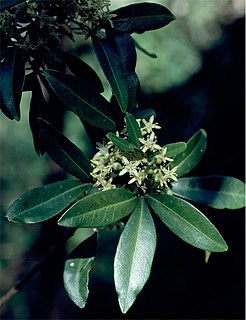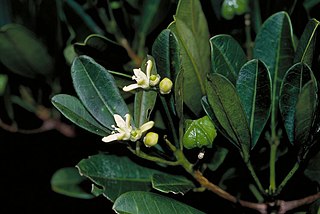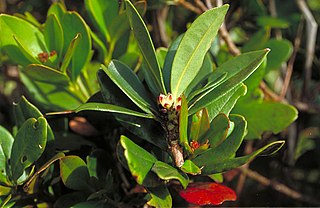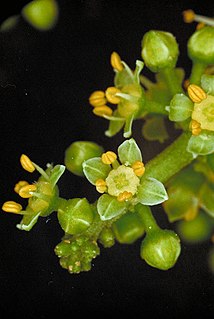Flindersia laevicarpa, commonly known in Australia as rose ash, scented maple or dirran maple, is a species of medium-sized to large tree in the family Rutaceae and is native to Papua New Guinea, West Papua and Queensland. It has pinnate leaves with four to eight egg-shaped to elliptical leaflets, panicles of cream-coloured, yellowish, red or purple flowers and smooth woody fruit that split into five at maturity, releasing winged seeds.

Acronychia pubescens, commonly known as hairy acronychia or hairy aspen, is a species of tall shrub or small tree that is endemic to eastern Australia. It usually has trifoliate leaves, rarely simple leaves, groups of whitish flowers in leaf axil|s and creamy to yellowish, elliptical to spherical fruit.

Acronychia suberosa , commonly known as corky acronychia, is a species of small to medium-sized rainforest tree that is endemic to eastern Australia. It has mostly trifoliate leaves with ellitic to egg-shaped leaflets with the narrower end towards the base, small groups of cream-coloured flowers and elliptical to spherical, creamy yellow to whitish fruit.

Medicosma cunninghamii, commonly known as pinkheart or bonewood, is a species of shrub or small tree in the family Rutaceae and is endemic to eastern Australia. It has simple, narrow oblong to lance-shaped leaves and small white or cream-coloured flowers arranged in small groups.

Acronychia chooreechillum, commonly known as mountain aspen, is a species of shrub or small rainforest tree that is endemic to north-eastern Queensland. It has mostly trifoliate leaves with elliptic to egg-shaped leaflets on stems that are more or less cylindrical, flowers in small groups in leaf axils and fleshy, egg-shaped or elliptical fruit.

Acronychia parviflora is a species of shrub or small rainforest tree that is endemic to north-eastern Queensland. It has simple, egg-shaped to elliptical leaves, flowers arranged singly or in small groups in leaf axils and fleshy, more or less spherical fruit.
Medicosma elliptica, commonly known as Bulburin medicosma, is a species of shrub or small tree in the family Rutaceae and is endemic to a restricted area of Queensland. It has elliptical leaves and white flowers borne singly or in small groups in leaf axils.

Medicosma fareana, commonly known as white aspen, is a species of rainforest small tree in the family Rutaceae and is endemic to north Queensland. It has elliptical leaves and white or cream-coloured flowers borne singly or in small groups in leaf axils.
Medicosma forsteri is a species of small tree in the family Rutaceae and is endemic to a restricted area of Queensland. It has elliptical leaves and cream-coloured flowers borne singly or in small groups in leaf axils.

Medicosma glandulosa is a species of shrub or small tree in the family Rutaceae and is endemic to far north Queensland. It has elliptical to egg-shaped leaves and flowers that are white with red tips or cream-coloured, borne singly or in small groups in leaf axils.
Medicosma heterophylla is a species of small tree in the family Rutaceae and is endemic to a restricted area of far north Queensland. It has simple and trifoliate, elliptical leaves and leaflets, and cream-coloured to pink or reddish flowers borne singly or in small groups in leaf axils.
Medicosma mulgraveana is a species of small tree in the family Rutaceae and is endemic to a restricted area of far north Queensland. It has mostly trifoliate leaves with elliptical to egg-shaped leaflets and white flowers borne in small groups in leaf axils.
Medicosma obovata is a species of shrub or small tree in the family Rutaceae and is endemic to a restricted area of far north Queensland. It has simple egg-shaped leaves with the narrower end towards the base and white flowers borne singly or in small groups in leaf axils.
Melicope affinis is a species of shrub or tree in the family Rutaceae and is endemic to Queensland. It has trifoliate leaves and small greenish white flowers borne in panicles in leaf axils.

Melicope broadbentiana, commonly known as false euodia, is a species of shrub or tree in the family Rutaceae and is endemic to Queensland. It has simple leaves, trifoliate leaves or both, and small white flowers borne in short panicles in leaf axils.
Melicope hayesii, commonly known as small-leaved doughwood, is a species of shrub or slender tree in the family Rutaceae and is endemic to eastern Australia. It has trifoliate leaves and small white flowers borne in panicles in leaf axils.

Melicope jonesii is a species of tree in the family Rutaceae and is endemic to north-east Queensland. It has trifoliate leaves and greenish or cream-coloured flowers borne in short panicles in leaf axils.

Melicope vitiflora, commonly known as northern evodia, fishpoison wood, leatherjacket or leatherwood, is a species of shrub or small tree in the family Rutaceae and is native to north-eastern Australia and New Guinea. It has trifoliate leaves and green to white or cream-coloured flowers borne in panicles in leaf axils.

Melicope xanthoxyloides is a species of small tree in the family Rutaceae and is native to New Guinea and Queensland. It has trifoliate leaves and small green to yellow or cream-coloured flowers arranged in panicles in leaf axils.

Philotheca queenslandica is a species of flowering plant in the family Rutaceae and is endemic to south-eastern Queensland. It is a wiry shrub with elliptic to egg-shaped leaves with the narrower end toward the base and densely crowded near the ends of the glandular-warty branchlets, and cream-coloured flowers tinged with pink and arranged singly in leaf axils.













